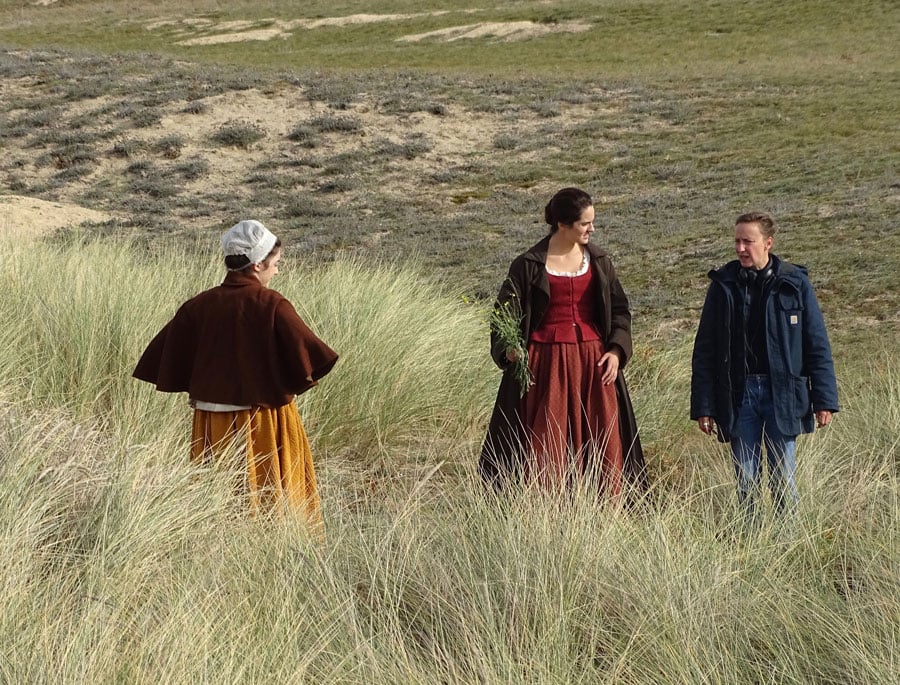Reel Thoughts: Portrait of a Lady on Fire only needed the female gaze
March 5, 2020
The Monthly
Céline Sciamma’s “Portrait of a Lady on Fire” would pass the Bechdel Test with flying colors. That’s partly because the period piece only stars women (sans the first and last ten minutes). It’s also the first film directed by a woman to win the Queer Palm at the 2019 Cannes Film Festival.
In this narrative, women take up space in their most sensual, devastating forms. And
the absence of male presence — and for what it’s worth, the male gaze — feels liberating.
For most of the movie, its main female characters are insulated on an isolated island, in a dark, candle-lit mansion that echoes with every noise they make, and this is punctuated by the general lack of a score. When there is music, it’s Presto from Vivaldi’s Summer, an agitating third section in a concerto otherwise portraying seasonal bliss.
In the movie, Marianne, (Noémie Merlant) a painter, arrives on a remote island to secretly paint a portrait of Héloïse, (Adèle Haenel) which has been commissioned by her mother so that she can marry her daughter off to a Milanese nobleman.
For her part, Héloïse, who just left a convent to be groomed for marriage, refuses to be painted — it is heavily implied her sister killed herself by jumping off the island’s cliff to escape the fate of an arranged marriage. But Héloïse assures Marianne, unlike her sister, she doesn’t want to die. She’s just angry.
In the following days, Marianne follows Héloïse on her walks to the beach, discretely catching every glimpse of her features to transpose onto the canvas. Marianne succeeds, but when she tells her the truth reveals the portrait, Héloïse is disappointed in how Marianne perceived her. The artist starts over, blurring Héloïse’s face with a rag (adding a new meaning to “paint me like one of your French girls”).
Outstanding acting and chemistry between Melant and Haenel make their bond seem eternal, even though their time together is limited and illicit. The color palette of the film is devoid of bright warm colors, accentuating the harsh, white cliffs and the turbulent waters encircling the island.
So when Héloïse’s dress catches on fire at a bonfire, the viewers feel gazed upon. It’s a mirage of a woman resigned to her fate, escaping for a fleeting, singular moment. Marianne chooses to immortalize this moment, giving the film its namesake.
The screening left me feeling good about the cinematic depictions of queer love. Granted, the only other French movie that depicts love between women I’ve watched is “Blue is the Warmest Colour,” known mostly for its sex scenes, which ended up feeling like a fetishized manifestation of male fantasy. Female leads of the film later accused the director of exploitive shooting practices.
“Portrait of a Lady on Fire” did not feel this way. It’s a visual diorama that is quiet but haunting, forlorn in its resonance. Sure, it’s not perfect. It’s slightly slow in pacing and it depicts a relationship between two “conventionally-beautiful” European women. But the love feels equal, tender and without slightly-questionable age gaps (I’m looking at you “Call Me By Your Name”).
The positive of reviewing “Portrait of a Lady on Fire” is that there is really nothing to spoil, so it makes the job easy. It’s a period piece about a gay relationship — and it’s transparent from the beginning about the nature of its ending. It’s not a tragedy, and it doesn’t try to be. It’s extravagant without delusions of grandeur. And after Sciamma and Haenel recently walked out on Roman Polanski’s win at the César Ceremony, it’s just hard not to fall in love with the director and cast.
It’s a film you watch and dare not blink for the fear you will miss a silhouette, a smile or a curvature in queer portraiture. Even if you do, “Portrait of a Lady on Fire” is a slow burn.
Email: yunkyokim2022@u.northwestern.edu
Twitter: @yunkyomoonk

